Assessing Shallow Groundwater Depth and Electrical Conductivity in the Brazilian Semiarid: A Geostatistical Analysis
Abstract
1. Introduction
2. Materials and Methods
2.1. Study Area
2.2. Hydrogeologic Framework
2.3. Groundwater Level and Electrical Conductivity Data
2.4. Meteorological Data
2.5. Agricultural Land Cover Change Analysis
2.6. Data Analysis
2.6.1. Geostatistical Framework
2.6.2. Trend Test
3. Results and Discussion
3.1. Climatic Conditions and Rainfall Temporal Distribution
3.2. Land Use Dynamics in the Mimoso Stream Basin and Its Influence on Groundwater Flows
3.3. Groundwater Availability and Quality Temporal Distribution
3.4. Groundwater Availability and Quality Spatial Distribution
4. Conclusions
Author Contributions
Funding
Data Availability Statement
Acknowledgments
Conflicts of Interest
References
- Williams, S.A.; Megdal, S.B.; Zuniga-Teran, A.A.; Quanrud, D.M.; Christopherson, G. Mapping Groundwater Vulnerability in Arid Regions: A Comparative Risk Assessment Using Modified DRASTIC Models, Land Use, and Climate Change Factors. Land 2025, 14, 58. [Google Scholar] [CrossRef]
- Bouchaou, L.; Alfy, M.; El Shanafield, M.; Siffeddine, A.; Sharp, J. Groundwater in Arid and Semi-Arid Areas. Geosciences 2024, 14, 332. [Google Scholar] [CrossRef]
- Wang, W.; Chen, Y.; Chen, Y.; Wang, W.; Zhang, T.; Qin, J. Groundwater dynamic influenced by intense anthropogenic activities in a dried-up river oasis of Central Asia. Hydrol. Res. 2022, 53, 532–546. [Google Scholar] [CrossRef]
- Hirata, R.; Suhogusoff, A.; Marcellini, S.; Villar, P.; Marcellini, L. As Águas Subterrâneas e Sua Importância Ambiental e Socioeconômica Para o Brasil; Universidade de São Paulo—Instituto de Geociências: São Paulo, Brazil, 2019. [Google Scholar]
- Montenegro, A.A.A.; Montenegro, S.M.G.L. Variabilidade espacial de classes de textura; salinidade e condutividade hidráulica de solos em planicie aluvial. Rev. Bras. Eng. Agric. Ambient. 2006, 10, 30–37. [Google Scholar] [CrossRef]
- Fontes Júnior, R.V.P.; Montenegro, A.A.A. Temporal dependence of potentiometric levels and groundwater salinity in alluvial aquifer upon rainfall and evapotranspiration. Rev. Bras. Recur. Hidr. 2017, 22, e54. [Google Scholar] [CrossRef][Green Version]
- Almeida, T.A.B.; Montenegro, A.A.A.; Mackay, R.; Montenegro, S.M.G.L.; Coelho, V.H.R.; de Carvalho, A.A.; da Silva, T.G.F. Hydrogeological Trends in an Alluvial Valley in the Brazilian Semiarid: Impacts of Observed Climate Variables Change and Exploitation on Groundwater Availability and Salinity. J. Hydrol. Reg. Stud. 2024, 53, 101784. [Google Scholar] [CrossRef]
- Coelho, V.H.R.; Montenegro, S.; Almeida, C.N.; Silva, B.B.; Oliveira, L.M.; Gusmão, A.C.V.; Freitas, E.S.; Montenegro, A.A.A. Alluvial groundwater recharge estimation in semi-arid environments using remotely sensed data. J. Hydrol. 2017, 548, 1–15. [Google Scholar] [CrossRef]
- Abera, K.A.; Asfaw, B.A.; Doyoro, Y.G.; Gebreyohanes, T.; Hussien, A.; Berhane, G.; Hagos, M.; Romha, A.; Walraevens, K. Assessing Shallow Groundwater Quality Around the Sheba Leather Tannery Area, Wikro, North Ethiopia: A Geophysical and Hydrochemical Study. Geosciences 2024, 14, 324. [Google Scholar] [CrossRef]
- Almeida, T.A.B.; Montenegro, A.A.A.; de Lima, J.L.M.P.; Farias, C.W.L.A.; Carvalho, A.A.; de Paiva, A.L.R. Spatiotemporal Variability of Groundwater Quality for Irrigation: A Case Study in Mimoso Alluvial Valley, Semiarid Region of Brazil. Water 2025, 17, 410. [Google Scholar] [CrossRef]
- Talib, A.; Desai, A.R.; Huang, J. Spatial and temporal forecasting of groundwater anomalies in complex aquifer undergoing climate and land use change. J. Hydrol. 2024, 639, 131525. [Google Scholar] [CrossRef]
- Fontes Júnior, R.; Montenegro, A. Impact of land use changes on the water balance in a representative watershed in the semiarid of the state of Pernambuco using the SWAT model. Eng. Agric. 2019, 39, 110–117. [Google Scholar] [CrossRef]
- Gomes, G.D.; Nunes, A.M.B.; Libonati, R.; Ambrizzi, T. Projections of subcontinental changes in seasonal precipitation over the two major river basins in South America under an extreme climate scenario. Clim. Dyn. 2022, 58, 1147–1169. [Google Scholar] [CrossRef]
- Hussain, S.; Wang, Y.; Awais, M.; Sajjad, M.M.; Ejaz, N.; Javed, U.; Waqas, M.; Zhe, X.; Iqbal, J. Integrated assessment of groundwater quality dynamics and Land use/land cover changes in rapidly urbanizing semi-arid region. Environ. Res. 2024, 260, 119622. [Google Scholar]
- de Oliveira, M.E.G.; da Silva, M.V.; de Almeida, G.L.P.; Pandorfi, H.; Oliveira Lopes, P.M.; Manrique, D.R.C.; dos Santos, A.; Jardim, A.M.d.R.F.; Giongo, P.R.; Montenegro, A.A.; et al. Investigation of pre and post environmental impact of the lockdown (COVID-19) on the water quality of the Capibaribe and Tejipió rivers, Recife metropolitan region, Brazil. J. S. Am. Earth Sci. 2022, 118, 103965. [Google Scholar] [CrossRef]
- Zhang, X.; Wu, X.; Zhao, R.; Mu, W.; Wu, C. Identifying the facts and driving factors of deceleration of groundwater table decline in Beijing during 1999–2018. J. Hydrol. 2022, 607, 127475. [Google Scholar] [CrossRef]
- Pereira, B.S.; Uchôa, J.G.S.M.; Freitas, G.S.; Meira Neto, A.A.; Anache, J.A.A.; Wendland, E.C.; Mendiondo, E.M.; Medeiros, P.H.A. Hydrological heritage: A historical exploration of human–water dynamics in northeast Brazil. Hydrol. Sci. J. 2025, 70, 546–558. [Google Scholar] [CrossRef]
- Patel, M.P.; Gami, B.; Patel, A.; Patel, P.; Patel, B. Climatic and Anthropogenic Impact on Groundwater Quality of Agriculture Dominated Areas of Southern and Central Gujarat, India. Groundw. Sustain. Dev. 2020, 10, 100306. [Google Scholar]
- Boufekane, A.; Saighi, O. Assessing groundwater quality for irrigation using geostatistical methods—Case of Wadi Nil Plain (North-East Algeria). Groundw. Sustain. Dev. 2019, 8, 179–186. [Google Scholar] [CrossRef]
- Dane, K. Sustainable Management of Groundwater Resources in Rosario-Mimoso Valley, Northeast Brazil. PhD Thesis, Hydrogeol. University of Newcastle, Callaghan, Australia, 2005; 120p. [Google Scholar]
- Montenegro, S.M.G.L.; Montenegro, A.A.A.; Mackay, R.; Oliveira, A.S.C. Dinâmica hidro-salina em aquífero aluvial utilizado para agricultura irrigada familiar em região semiárida. Rev. Bras. Recur. Hidr. 2003, 8, 85–92. [Google Scholar]
- Bouwer, H.; Rice, R.C. A slug test for determining hydraulic conductivity of unconfined aquifers with completely or partially penetrating wells. Water Resour. Res. 1976, 12, 423–428. [Google Scholar]
- Montenegro, A.A.A. Stochastic Hydrologeological Modelling of Aquifer Salinization from Small Scale Agriculture in Northeast Brazil. Ph.D. Thesis, University of Newcastle, Callaghan, Australia, 1997; 272p. [Google Scholar]
- Corrêa, M.M.; Ribeiro, M.R. Levantamento Detalhado de Solos da Fazenda Nossa Senhora do Rosário (Pesqueira-PE); Relatório Técnico; UFRPE/UFPE/CNPq/BNB: Recife, Brazil, 2001; 35p. [Google Scholar]
- Andrade, T.S.; Montenegro, S.M.G.L.; Montenegro, A.A.A.; Rodrigues, D.F.B. Estimation of alluvial recharge in the semiarid. Eng. Agric. 2014, 34, 211–221. [Google Scholar] [CrossRef]
- Allen, R.G.; Pereira, L.S.; Raes, D.; Smith, M. Crop Evapotranspiration—Guidelines for Computing Crop Water Requirements, 1st ed.; FAO Irrigation and Drainage Paper 56; FAO: Rome, Italy, 1998; pp. 1–297. [Google Scholar]
- Warrick, A.W.; Nielsen, D.R. Spatial variability of soil physical properties in the field. In Applications of Soil Physics; Hillel, D., Ed.; Academic Press: New York, NY, USA, 1980; Chapter 2; pp. 319–344. [Google Scholar]
- Hoaglin, D.C.; Mosteller, F.; Tukey, J.W. Análise Exploratória de Dados: Técnicas Robustas; Salamandra: Lisboa, Portugal, 1992; 446p. [Google Scholar]
- GEO-EAS 1.2.1, Geostatistical Environmental Assessment Software User’s Guide; Publication No. EPA/600/4-88/033; United States Environmental Protection Agency: Washington, DC, USA, 1991.
- Journel, A.G. Fundamentals of Geostatistics in Five Lessons; American Geophysical Union: Washington, DC, USA, 1989; 40p. [Google Scholar]
- Webster, R.; Oliver, M.A. Geostatistics for Environmental Scientists, 2nd ed.; Wiley: Chichester, UK, 2007. [Google Scholar]
- Cambardella, C.A.; Moorman, T.B.; Novak, J.M.; Parkin, T.B.; Karlen, D.L.; Turco, R.F.; Kornopka, A.E. Field-Scale Variability of Soil Properties in Central Iowa Soils. Soil Sci. Soc. Am. J. 1994, 58, 1501–1511. [Google Scholar]
- Golden Software. Surfer for Windows; Version 9.0; Golden Software: Golden, CO, USA, 2010; 66p. [Google Scholar]
- Mann, H.B. Nonparametric tests against trend. Econometrica 1945, 13, 245–259. [Google Scholar] [CrossRef]
- Kendall, M.G. Rank Correlation Methods; Griffin: London, UK, 1975. [Google Scholar]
- Sen, P.K. Estimates of the regression coefficient based on Kendall’s tau. J. Am. Stat. Assoc. 1968, 63, 1379–1389. [Google Scholar]
- Cheng, B.; Zhang, Y.; Xia, R.; Wang, L.; Zhang, N.; Zhang, X. Spatiotemporal analysis and prediction of water quality in the Han River by an integrated nonparametric diagnosis approach. J. Clean. Prod. 2021, 328, 129583. [Google Scholar] [CrossRef]
- Marengo, J.A.; Galdos, M.V.; Challinor, A.; Cunha, A.P.; Marin, F.R.; Vianna, M.d.S.; Alvala, R.C.S.; Alves, L.M.; Moraes, O.L.; Bender, F. Drought in Northeast Brazil: A review of agricultural and policy adaptation options for food security. Clim. Resil. Sustain. 2022, 1, e17. [Google Scholar] [CrossRef]
- Andrade, T.S.; Montenegro, S.M.G.L.; Montenegro, A.A.A.; Rodrigues, D.F.B. Variabilidade espaco-temporal da condutividade eletrica da agua subterrânea na regi.o semiarida de Pernambuco. Rev. Bras. Eng. Agric. Ambient. 2012, 16, 496–504. [Google Scholar]
- dos Santos, A.L.M.; Gonçalves, W.A.; Andrade, L.d.M.B.; Rodrigues, D.T.; Batista, F.F.; Lima, G.C.; e Silva, C.M.S. Space–Time Characterization of Extreme Precipitation Indices for the Semiarid Region of Brazil. Climate 2024, 12, 43. [Google Scholar] [CrossRef]
- Soares, N.S.; Costa, C.A.G.; Carneiro de Lima, J.B.; Francke, T.; de Araújo, J.C. Method for identification of hydrological seasons in the semi-arid Caatinga biome, Brazil. Hydrol. Sci. J. 2024, 69, 309–320. [Google Scholar] [CrossRef]
- IPCC. Climate Change 2021: The Physical Science Basis. Contribution of Working Group I to the Sixth Assessment Report of the Intergovernmental Panel on Climate Change; Masson-Delmotte, V., Zhai, P., Pirani, A., Connors, S.L., Péan, C., Berger, S., Caud, N., Chen, Y., Goldfarb, L., Gomis, M.I., et al., Eds.; Cambridge University Press: Cambridge, UK, 2021; Available online: https://www.ipcc.ch/report/ar6/wg1/chapter/chapter-11/?utm_source=chatgpt.com (accessed on 3 January 2025).
- Xu, L.; Gong, H.; Chen, B.; Zhou, C.; Zhong, X.; Ma, Z.; Meng, D. Characterizing Groundwater Level Response to Precipitation at Multiple Timescales in the Lubei Plain Region Using Transfer Function Analysis. Remote Sens. 2025, 17, 208. [Google Scholar] [CrossRef]
- Andrade, C.W.L.; Montenegro, S.M.G.L.; Montenegro, A.A.A.; Lima, J.R.S.; Srinivasan, R.; Jones, C.A. Climate change impact assessment on water resources under RCP scenarios: A case study in Mundaú River Basin, Northeastern Brazil. Int. J. Climatol. 2020, 41, E1045–E1061. [Google Scholar] [CrossRef]
- Anjinho, P.S.; Barbosa, M.A.G.A.; Costa, C.W.; Mauad, F.F. Environmental fragility analysis in reservoir drainage basin land use planning: A Brazilian basin case study. Land Use Policy 2021, 100, 104946. [Google Scholar] [CrossRef]
- Silva, G.R.; da Muniz, R.S.; Oliveira Júnior, A.I.; de Pereira Valões, D.C.; Pereira, D.D.d.M. Caracterização da Bacia Hidrográfica do rio Pajeú—PE, situada na Bacia do São Francisco. Rev. Geogr. 2022, 39, 208–221. [Google Scholar] [CrossRef]
- Marengo, J.A.; Cunha, A.P.; Alves, L.M. A seca de 2012-15 no semiárido do Nordeste do Brasil no contexto histórico. Climanalise 2016, 4, 49–54. [Google Scholar]
- Montenegro, A.A.A.; Ragab, R. Hydrological response of a Brazilian semiarid catchment to different land use and climate change scenarios: Modeling study. Hydrol. Process. 2010, 24, 2705–2723. [Google Scholar] [CrossRef]
- Lins, F.A.C.; Montenegro, A.A.A.; Farias, C.W.L.A.; Silva, M.V.; Souza, W.M.; Moura, G.B.A.; Silva, T.G.F.; Montenegro, S.M.G.L. Soil moisture and hydrological processes dynamics under climate and land use changes in a semiarid experimental basin, Brazil. Ecohydrol. Hydrobiol. 2024, 24, 681–697. [Google Scholar] [CrossRef]
- Santiago, C.M.C.; Silva, E.V.; Soares, L.S. Capacidade de suporte dos sistemas ambientais da bacia hidrográfica do Rio São Nicolau (BHSN)-Piauí. Geografia 2023, 48, 1–24. [Google Scholar] [CrossRef]
- Kebede, M.M.; Kumar, M.; Mekonnen, M.M.; Clement, T.P. Enhancing Groundwater Recharge Through Nature-Based Solutions: Benefits and Barriers. Hydrology 2024, 11, 195. [Google Scholar] [CrossRef]
- Ribeiro, L.; Kretschmer, N.; Nascimento, J.; Buxo, A.; Rötting, T.; Soto, G.; Oyarzún, J.; Maturana, H.; Oyarzún, R.; Kretschmer, N.; et al. Evaluating piezometric trends using the Mann- Kendall test on the alluvial aquifers of the Elqui River basin, Chile Evaluating piezometric trends using the Mann-Kendall test on the alluvial aquifers of the Elqui River basin, Chile. Hydrol. Sci. J. 2015, 6667, 1840–1852. [Google Scholar] [CrossRef]
- Hibbs, B.J.; Eastoe, C.J.; Merino, M. Issues of Bias in Groundwater Quality Data Sets in an Irrigated Floodplain Aquifer of Variable Salinity. Geosciences 2024, 14, 66. [Google Scholar] [CrossRef]
- Schiavo, M. Spatial modeling of the water table and its historical variations in Northeastern Italy via a geostatistical approach. Groundw. Sustain. Dev. 2024, 25, 101186. [Google Scholar] [CrossRef]
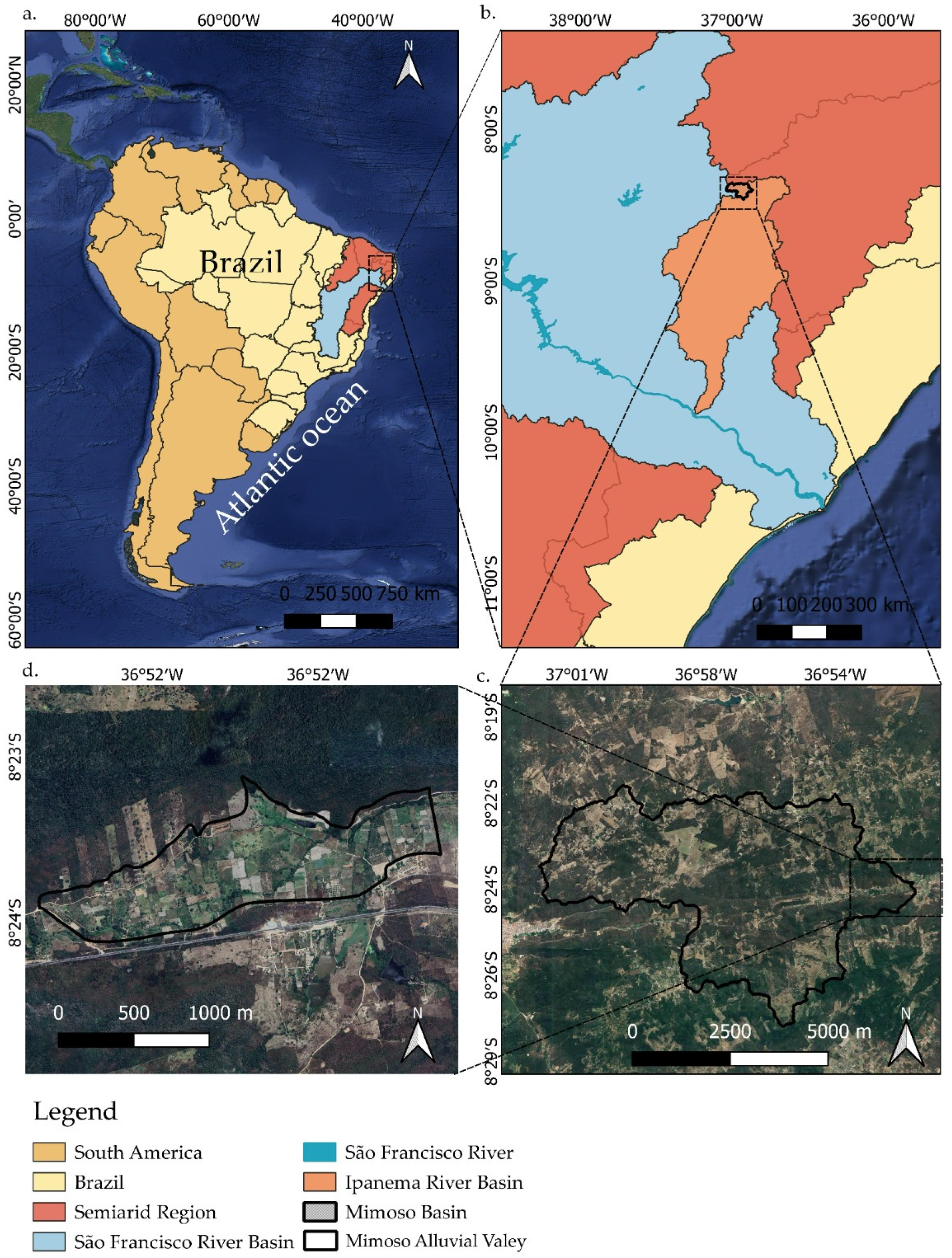

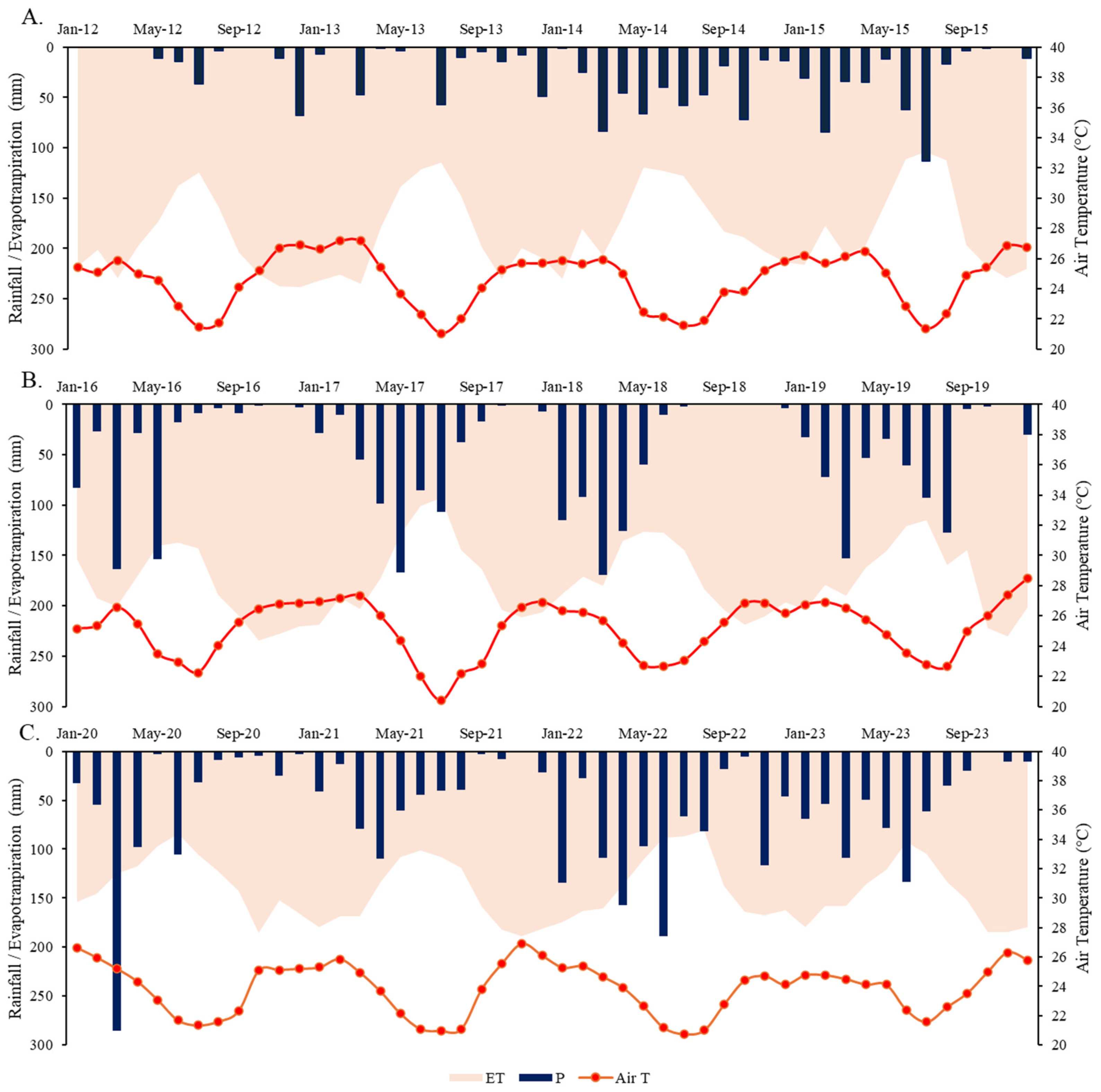
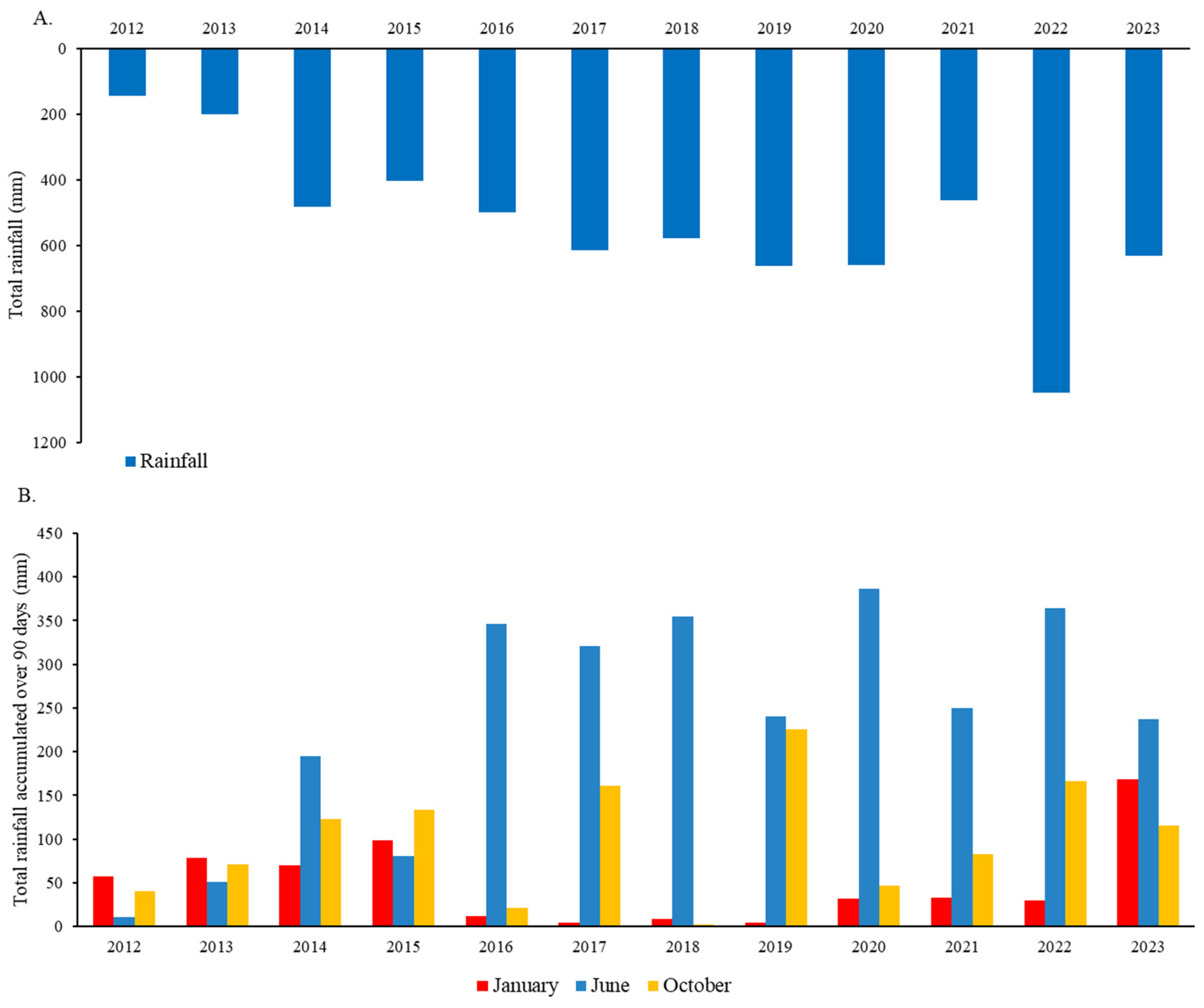
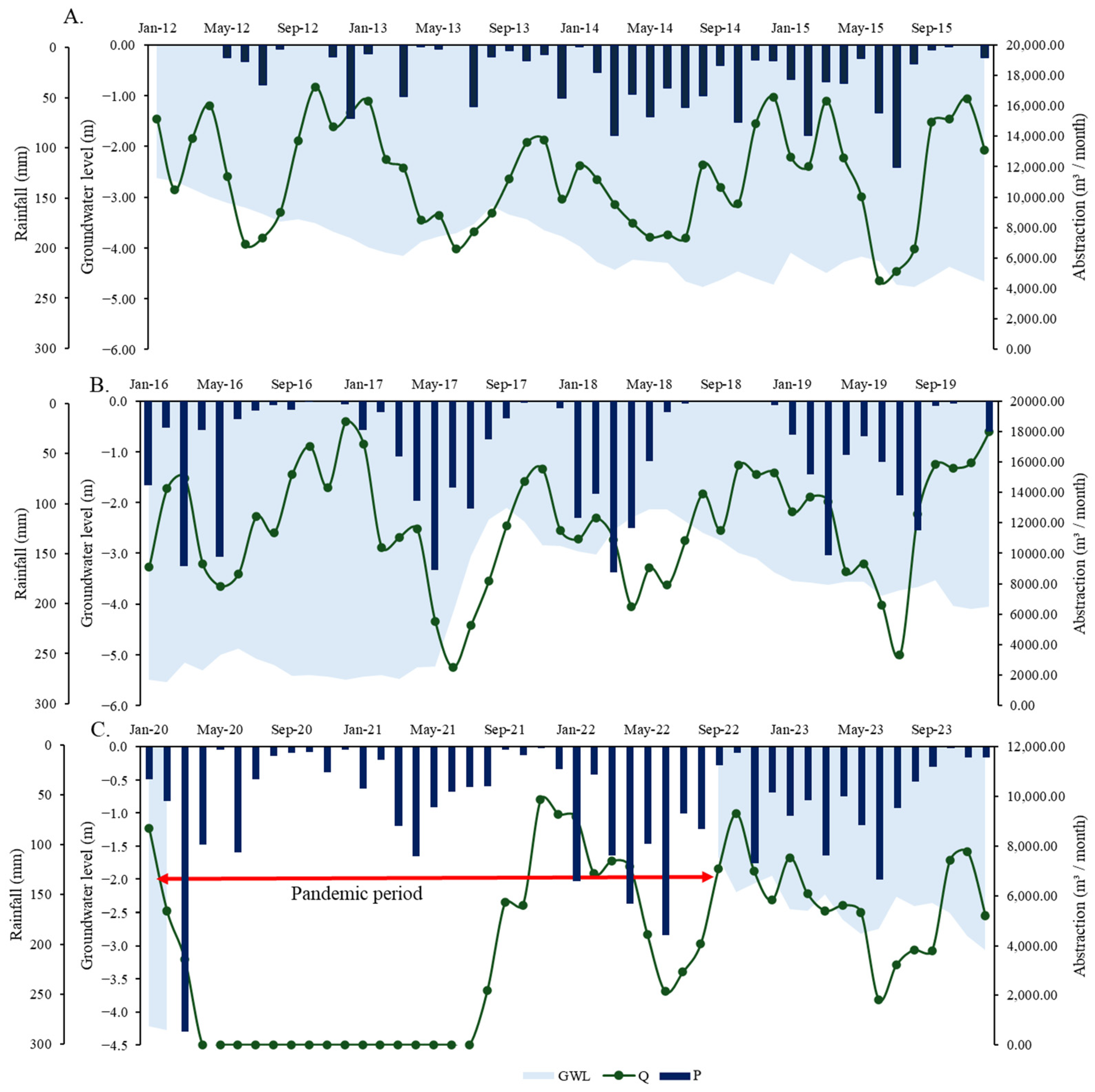


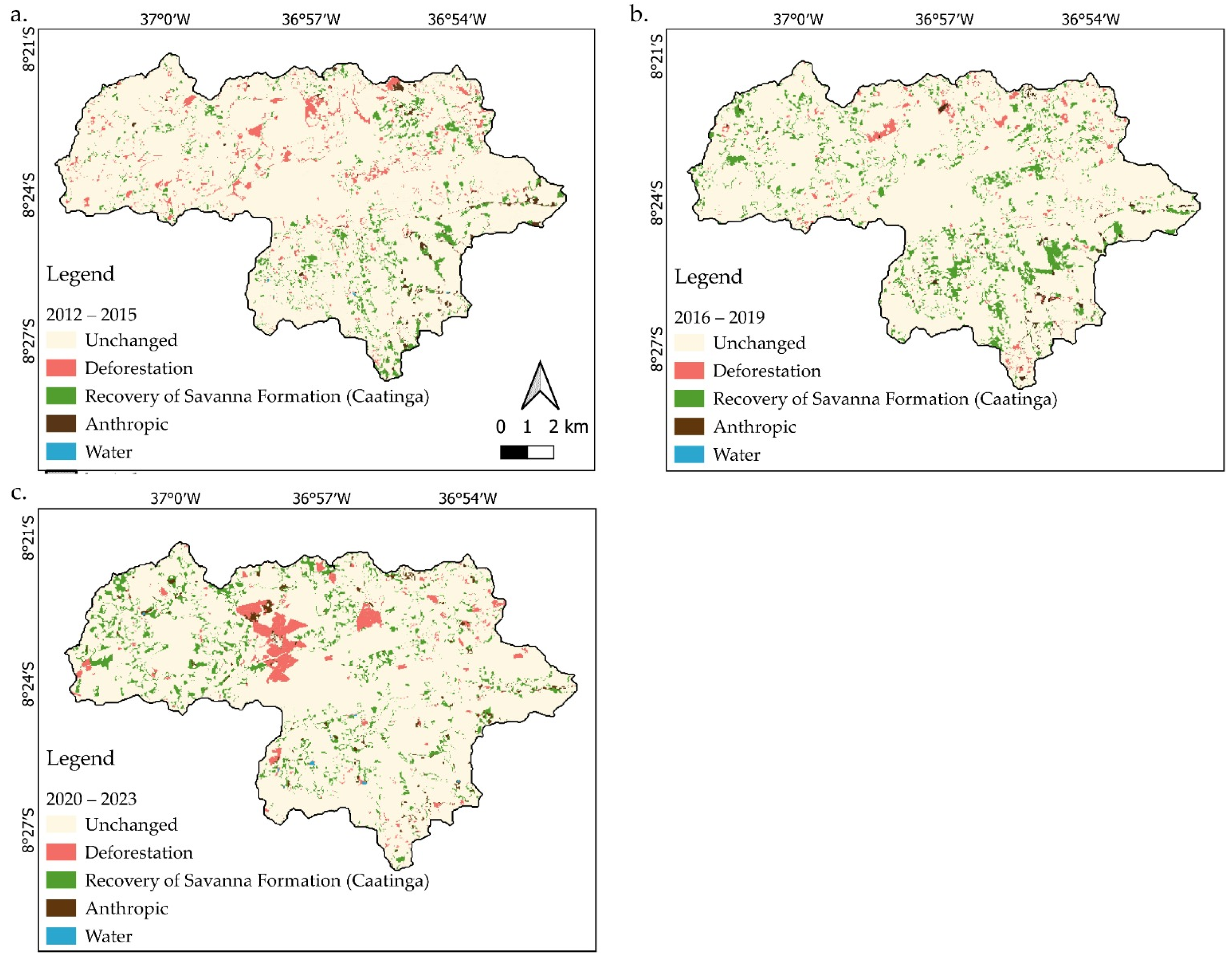
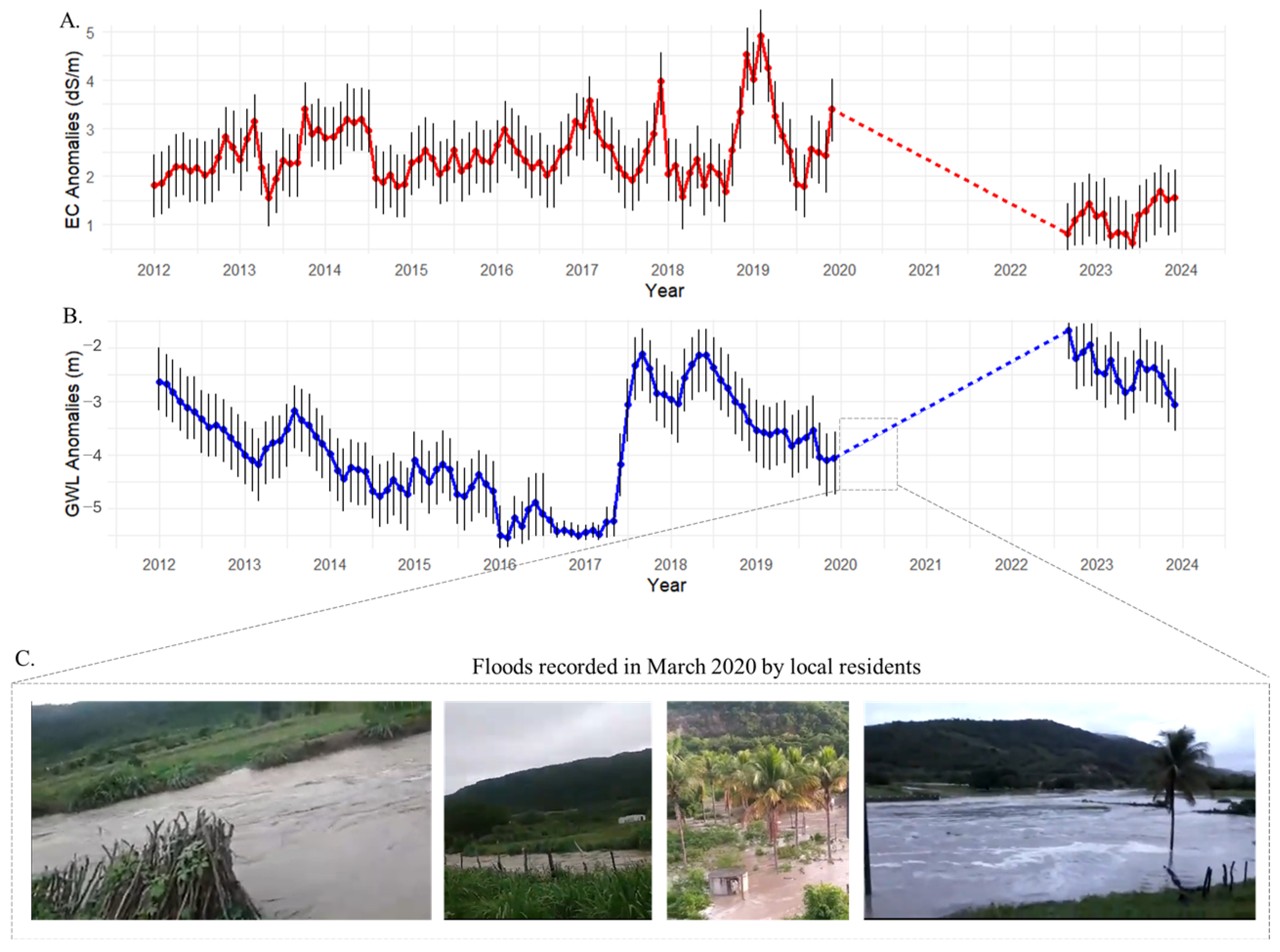
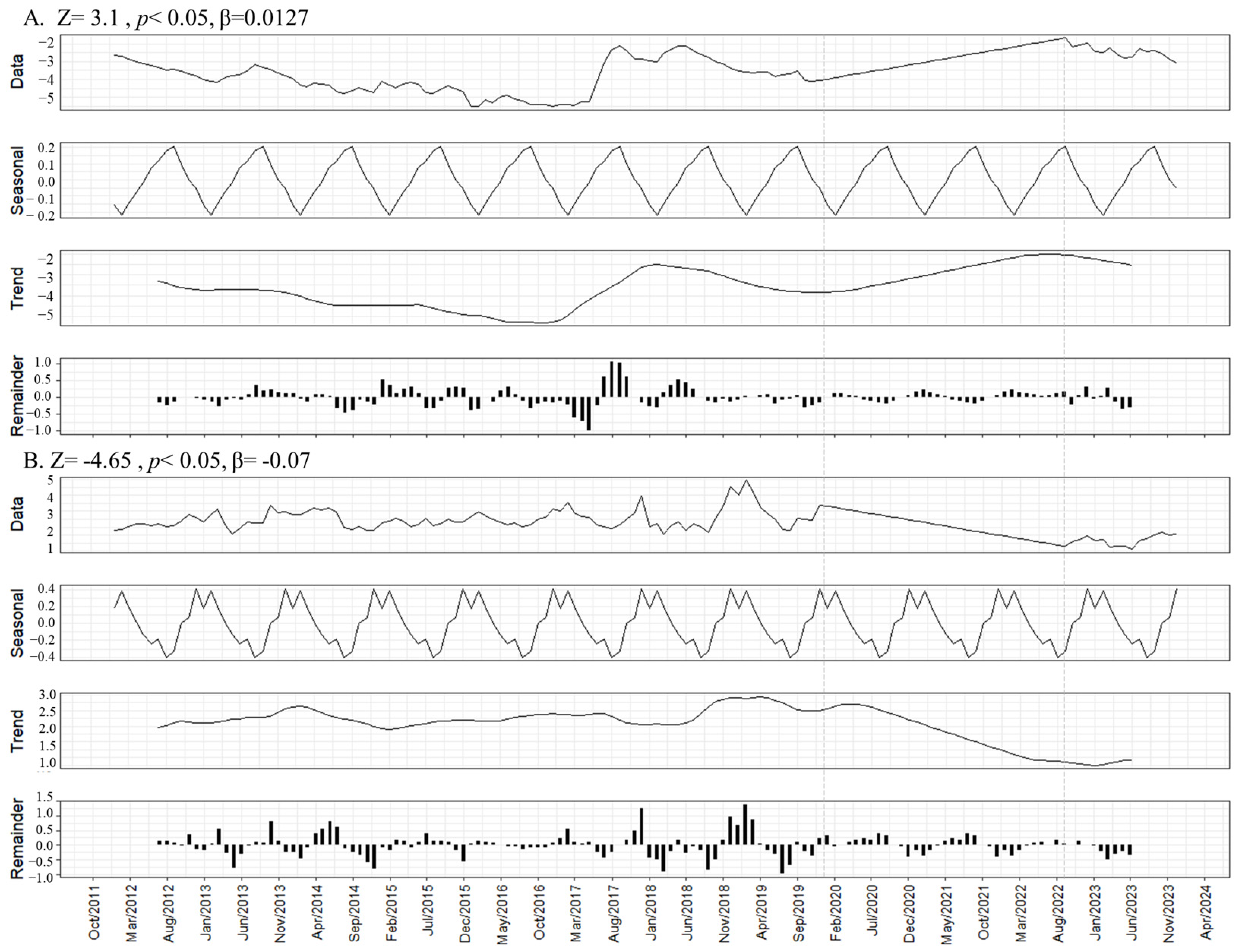


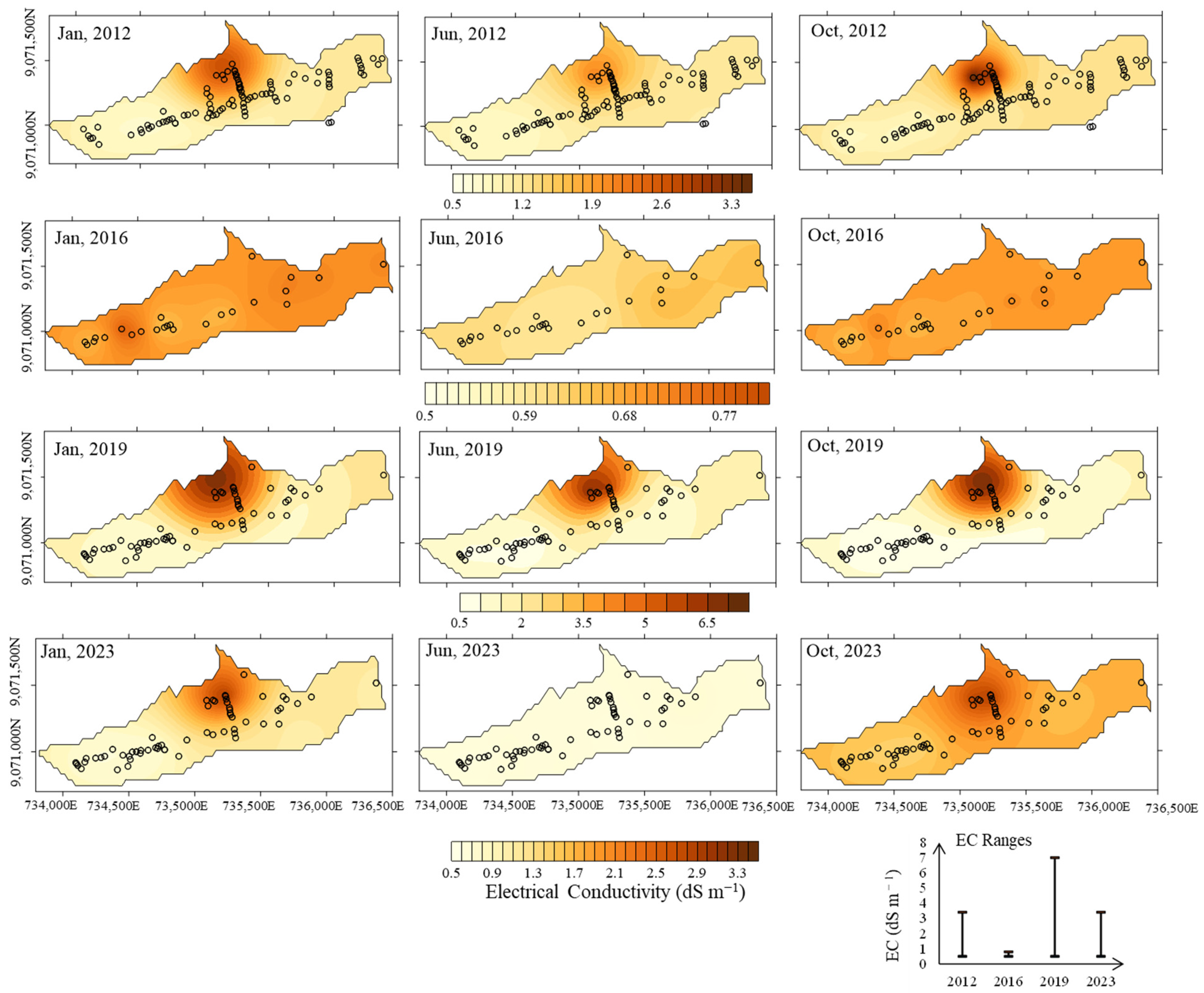
| Class | 2012 | 2016 | 2019 | 2023 | ||||
|---|---|---|---|---|---|---|---|---|
| Area | ||||||||
| (km2) | (%) | (km2) | (%) | (km2) | (%) | (km2) | (%) | |
| Forest formation | 2.31 | 1.88% | 2.31 | 1.88% | 2.31 | 1.88% | 2.31 | 1.88% |
| Savanna formation (caatinga) | 68.87 | 55.93% | 70.71 | 57.44% | 78.83 | 64.02% | 82.67 | 67.15% |
| Pasture | 49.86 | 40.50% | 48.90 | 39.72% | 40.63 | 33.00% | 32.92 | 26.74% |
| Mosaic of uses | 1.77 | 1.43% | 0.95 | 0.77% | 0.94 | 0.76% | 4.62 | 3.76% |
| Urban area | 0.18 | 0.15% | 0.19 | 0.15% | 0.24 | 0.19% | 0.27 | 0.22% |
| Other non-vegetated areas | 0.01 | 0.01% | 0.02 | 0.02% | 0.05 | 0.04% | 0.04 | 0.03% |
| Other temporary crops | - | - | 0.07 | 0.05% | 0.04 | 0.03% | 0.04 | 0.03% |
| River, lake, and ocean | 0.13 | 0.10% | 0.03 | 0.02% | 0.09 | 0.07% | 0.25 | 0.21% |
| Four-Year Periods | 2012–2015 | 2016–2019 | 2020–2023 | |||
|---|---|---|---|---|---|---|
| Land Use Change | Area | |||||
| (km2) | (%) | (km2) | (%) | (km2) | (%) | |
| Unchanged | 110.43 | 0.90 | 108.76 | 0.88 | 106.40 | 0.86 |
| Anthropic | 1.19 | 0.01 | 0.83 | 0.01 | 1.53 | 0.01 |
| Deforestation | 4.80 | 0.04 | 2.68 | 0.02 | 5.62 | 0.05 |
| Recovery of savanna formation (caatinga) | 6.57 | 0.05 | 10.82 | 0.09 | 9.47 | 0.08 |
| Water | 0.14 | 0.00 | 0.03 | 0.00 | 0.09 | 0.00 |
| 2012 | 2016 | 2019 | 2023 | |||||||||
|---|---|---|---|---|---|---|---|---|---|---|---|---|
| January | June | October | January | June | October | January | June | October | January | June | October | |
| A. Groundwater level (m) | ||||||||||||
| n | 84 | 73 | 68 | 36 | 33 | 32 | 46 | 41 | 42 | 38 | 26 | 34 |
| Mean | 2.65 | 3.17 | 3.92 | 5.65 | 4.48 | 5.67 | 3.60 | 3.95 | 4.28 | 2.46 | 2.74 | 2.53 |
| Median | 2.61 | 3.04 | 3.57 | 5.67 | 4.85 | 5.85 | 3.47 | 3.85 | 3.92 | 2.32 | 2.63 | 2.41 |
| Minimum | 0.50 | 1.20 | 2.25 | 0.30 | 0.30 | 0.30 | 1.00 | 1.15 | 2.15 | 1.28 | 1.00 | 0.91 |
| Maximum | 4.05 | 4.85 | 23.25 | 8.98 | 7.10 | 9.10 | 5.50 | 7.00 | 9.05 | 6.25 | 5.46 | 6.12 |
| Standard deviation | 0.48 | 0.52 | 0.87 | 1.22 | 1.42 | 1.37 | 0.82 | 1.07 | 1.59 | 0.93 | 0.90 | 0.91 |
| CV (%) | 8.37 | 9.27 | 26.70 | 7.35 | 4.99 | 6.67 | 22.99 | 26.95 | 37.18 | 38.10 | 33.07 | 35.97 |
| KS | 0.15 | 0.12 | 0.08 | 0.15 | 0.12 | 0.11 | 0.15 | 0.17 | 0.10 | 0.14 | 0.08 | 0.09 |
| B. Electrical conductivity (dS m−1) | ||||||||||||
| n | 84 | 73 | 68 | 36 | 33 | 32 | 42 | 37 | 40 | 38 | 25 | 33 |
| Mean | 1.66 | 1.31 | 1.97 | 0.69 | 0.62 | 0.65 | 1.05 | 0.97 | 1.06 | 0.90 | 0.61 | 1.11 |
| Median | 0.69 | 0.58 | 0.76 | 0.63 | 0.62 | 0.61 | 0.88 | 0.79 | 0.74 | 0.53 | 0.59 | 0.68 |
| Minimum | 0.18 | 0.15 | 0.29 | 0.44 | 0.22 | 0.37 | 0.61 | 0.26 | 0.51 | 0.25 | 0.30 | 0.44 |
| Maximum | 27.50 | 20.04 | 26.91 | 1.35 | 1.06 | 1.20 | 3.32 | 5.48 | 6.38 | 5.27 | 1.22 | 6.99 |
| Standard deviation | 1.63 | 1.23 | 2.03 | 0.16 | 0.19 | 0.14 | 0.54 | 0.81 | 0.99 | 1.15 | 0.17 | 1.44 |
| CV (%) | 16.83 | 16.23 | 13.27 | 8.28 | 5.51 | 8.33 | 51.38 | 83.50 | 93.12 | 127.95 | 28.32 | 130.06 |
| KS | 0.18 | 0.09 | 0.09 | 0.18 | 0.09 | 0.95 | 0.19 | 0.10 | 0.10 | 0.17 | 0.08 | 0.09 |
| Year | Month | Model | Nugget (C0) | Sill (C0 + C1) | Range (A, m) | R2 | DSD (%) | Cross-Validation | |
|---|---|---|---|---|---|---|---|---|---|
| M | SD | ||||||||
| 1. Groundwater depth (m) | |||||||||
| 2012 | January | Exp | 0.16 | 0.36 | 294.0 | 0.8 | 43.9 | 0.15 | 1.10 |
| June | Exp | 0.14 | 0.49 | 385.1 | 0.8 | 28.3 | 0.08 | 1.03 | |
| October | Exp | 0.02 | 0.40 | 123.0 | 0.9 | 4.5 | 0.12 | 1.07 | |
| 2016 | January | Gauss | 0.13 | 0.47 | 374.0 | 0.8 | 27.7 | −0.11 | 0.84 |
| June | Gauss | 0.18 | 0.64 | 349.5 | 0.9 | 28.1 | 0.05 | 1.00 | |
| October | Gauss | 0.00 | 0.48 | 121.2 | 0.9 | 0.2 | 0.19 | 1.14 | |
| 2019 | January | Exp | 0.29 | 0.60 | 365.8 | 0.9 | 48.6 | −0.10 | 0.85 |
| June | Gauss | 0.40 | 0.85 | 278.5 | 0.9 | 46.8 | 0.04 | 0.99 | |
| October | Gauss | 0.17 | 0.44 | 333.5 | 0.9 | 38.1 | 0.10 | 1.05 | |
| 2023 | January | Exp | 0.02 | 0.38 | 171.0 | 0.8 | 5.8 | 0.12 | 1.07 |
| June | Gauss | 0.29 | 0.66 | 388.4 | 0.9 | 44.3 | 0.21 | 1.16 | |
| October | Gauss | 0.12 | 0.38 | 420.2 | 0.8 | 31.6 | −0.08 | 0.87 | |
| 2. Electrical conductivity (dS/m) | |||||||||
| 2012 | January | Gauss | 0.05 | 0.11 | 342.0 | 0.8 | 45.1 | 0.02 | 1.12 |
| June | Exp | 0.05 | 0.11 | 327.0 | 0.8 | 40.9 | 0.12 | 1.23 | |
| October | Exp | 0.00 | 0.14 | 135.0 | 0.9 | 0.9 | 0.06 | 1.17 | |
| 2016 | January | Gauss | 0.00 | 0.02 | 199.2 | 0.8 | 0.0 | −0.16 | 0.92 |
| June | Gauss | 0.00 | 0.05 | 114.3 | 0.9 | 0.0 | 0.03 | 1.13 | |
| October | Gauss | 0.01 | 0.02 | 251.1 | 0.9 | 66.7 | −0.06 | 1.03 | |
| 2019 | January | Gauss | 0.02 | 0.12 | 132.0 | 0.9 | 12.8 | 0.18 | 1.30 |
| June | Esf | 0.02 | 0.70 | 361.0 | 0.9 | 2.9 | 0.09 | 1.20 | |
| October | Gauss | 0.05 | 0.15 | 281.0 | 0.9 | 33.3 | 0.02 | 1.12 | |
| 2023 | January | Exp | 0.31 | 0.56 | 366.0 | 0.9 | 55.5 | 0.13 | 1.24 |
| June | Exp | 0.01 | 0.04 | 430.3 | 0.9 | 33.3 | 0.09 | 1.20 | |
| October | Gauss | 0.04 | 0.60 | 352.1 | 0.9 | 6.7 | −0.10 | 0.99 | |
Disclaimer/Publisher’s Note: The statements, opinions and data contained in all publications are solely those of the individual author(s) and contributor(s) and not of MDPI and/or the editor(s). MDPI and/or the editor(s) disclaim responsibility for any injury to people or property resulting from any ideas, methods, instructions or products referred to in the content. |
© 2025 by the authors. Licensee MDPI, Basel, Switzerland. This article is an open access article distributed under the terms and conditions of the Creative Commons Attribution (CC BY) license (https://creativecommons.org/licenses/by/4.0/).
Share and Cite
Almeida, T.A.B.; Boaventura, L.C.d.S.; Silva, M.V.d.; Farias, C.W.L.d.A.; Chagas, A.M.S.d.; Costa, R.S.d.; Moura, C.V.d.S.; Montenegro, A.A.d.A. Assessing Shallow Groundwater Depth and Electrical Conductivity in the Brazilian Semiarid: A Geostatistical Analysis. Geosciences 2025, 15, 136. https://doi.org/10.3390/geosciences15040136
Almeida TAB, Boaventura LCdS, Silva MVd, Farias CWLdA, Chagas AMSd, Costa RSd, Moura CVdS, Montenegro AAdA. Assessing Shallow Groundwater Depth and Electrical Conductivity in the Brazilian Semiarid: A Geostatistical Analysis. Geosciences. 2025; 15(4):136. https://doi.org/10.3390/geosciences15040136
Chicago/Turabian StyleAlmeida, Thayná Alice Brito, Luiz Carlos da Silva Boaventura, Marcos Vinícius da Silva, Carolyne Wanessa Lins de Andrade Farias, Aline Maria Soares das Chagas, Rodrigo Soares da Costa, Cláudio Vinícius de Souza Moura, and Abelardo Antônio de Assunção Montenegro. 2025. "Assessing Shallow Groundwater Depth and Electrical Conductivity in the Brazilian Semiarid: A Geostatistical Analysis" Geosciences 15, no. 4: 136. https://doi.org/10.3390/geosciences15040136
APA StyleAlmeida, T. A. B., Boaventura, L. C. d. S., Silva, M. V. d., Farias, C. W. L. d. A., Chagas, A. M. S. d., Costa, R. S. d., Moura, C. V. d. S., & Montenegro, A. A. d. A. (2025). Assessing Shallow Groundwater Depth and Electrical Conductivity in the Brazilian Semiarid: A Geostatistical Analysis. Geosciences, 15(4), 136. https://doi.org/10.3390/geosciences15040136








